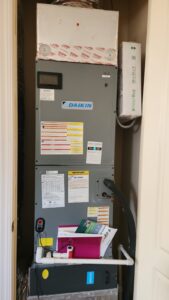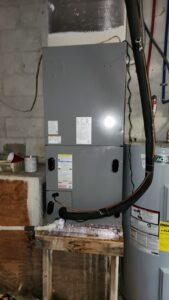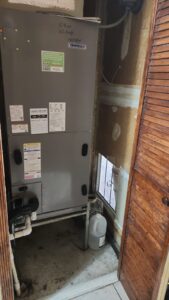Why Does Your Furnace Blows Cold Air?
Experiencing a cold breeze instead of warm comfort from your furnace can be perplexing and frustrating. Let’s explore the reasons behind this common issue and how to fix it.
Thermostat Settings: A Key Factor in Furnace Performance
One of the first things to check when is blowing cold air is the thermostat settings. The thermostat acts as the control center for your heating system, and incorrect settings can lead to issues with the temperature of the air being circulated in your home. Here are some aspects of thermostat settings to consider:
- Mode Setting: Ensure that your thermostat is set to “Heat” mode. If it’s set to “Cool” or “Off,” your furnace won’t produce warm air. During the transition from warmer to cooler months, it’s easy to overlook this simple setting.
- Fan Setting: The fan setting on your thermostat should typically be set to “Auto” rather than “On.” When set to “On,” the fan will run continuously, even when isn’t actively heating the air. This can result in cold air being circulated when the furnace cycles off. In contrast, the “Auto” setting ensures that the fan operates only when is heating the air.
- Temperature Setting: Check if the thermostat is set to a temperature higher than the current room temperature. If the set temperature is lower than or equal to the room temperature, won’t kick in to heat the home. Adjust the temperature setting accordingly to ensure the furnace activates and provides heat.
- Programmable Thermostat: If you have a programmable thermostat, verify that it’s programmed correctly for your current schedule. Incorrect programming can lead to not heating your home at the desired times, resulting in periods of cold air.
- Battery Check: If your thermostat is battery-operated, low batteries can cause erratic behavior. Replace the batteries if they haven’t been changed in a while or if the thermostat indicates low battery power.
- Calibration Issues: Sometimes, thermostats can become miscalibrated, meaning they don’t accurately measure the room temperature. This can cause it to turn off before your home reaches the desired temperature. If you suspect a calibration issue, consult an HVAC professional.
- Smart Thermostats: For those with smart thermostats, ensure that the device is connected to Wi-Fi and functioning correctly. Sometimes, connectivity issues can lead to a loss of control over your heating settings.
- Physical Location: The location of your thermostat can impact its performance. If it’s located near a draft, in direct sunlight, or away from the main living areas, it might not accurately read the home’s overall temperature. Consider relocating the thermostat if you suspect it’s in a poor location.
Overheating Furnace: A Common Cause of Cold Air Output
When your furnace blows cold air, one potential issue could be overheating. This might seem counterintuitive, but overheating can lead to a lack of warm air in your home. Here’s why this happens and what you can do about it:
- Safety Mechanisms: Modern furnaces are equipped with safety features that shut off the burners if overheating is detected. This is to prevent damage to the furnace and avoid potential safety hazards. When the burners shut off, the fan may continue to run, blowing cold air through the vents.
- Causes of Overheating: The most common cause of furnace overheating is restricted airflow. When can’t circulate air properly, it can’t dissipate heat as it’s designed to, leading to an increase in internal temperature.
- Dirty Air Filters: One of the primary culprits for restricted airflow is a dirty or clogged air filter. Over time, filters accumulate dust, pet hair, and other debris, which can significantly impede airflow. It’s essential to check your air filters regularly and replace them as needed – typically every 1-3 months, depending on usage and filter type.
- Blocked Vents and Registers: Ensure that all vents and registers in your home are open and unobstructed. Furniture, curtains, or rugs covering vents can restrict airflow, contributing to overheating.
- Internal Components: Other internal issues, such as a
malfunctioning blower motor or dirty furnace components can also lead to overheating. The blower motor is responsible for circulating air through your furnace and into your home. If it’s not working correctly, air movement is hindered, causing heat to build up within the furnace.
- Regular Maintenance: Regular maintenance is crucial to prevent overheating. This includes professional inspections where an HVAC technician can check for issues like a dirty heat exchanger, worn bearings in the blower motor, or other mechanical problems that might lead to overheating.
- Thermostat Fan Setting: If your thermostat’s fan setting is set to “On” instead of “Auto,” the fan will run continuously, even when the furnace isn’t heating. This can circulate cooler air when the burners are off due to overheating or regular cycling.
- Ductwork Issues: Leaks or blockages in your ductwork can also contribute to overheating. If heated air can’t flow freely through the ducts, it can cause back pressure and heat buildup in the furnace.
- Immediate Actions: If you suspect your furnace is overheating, turn it off immediately to prevent damage.
Pilot Light and Ignition Problems: Key Factors in Furnace Functionality
When your furnace is blowing cold air, issues with the pilot light or ignition system are common suspects, especially in older furnaces with a standing pilot light or newer models with electronic ignition. Understanding these components and how they affect your furnace’s operation is crucial for troubleshooting.
Pilot Light Issues in Older Furnaces
- Pilot Light Basics: In older furnaces, a continuously burning pilot light is used to ignite the gas burner. If this pilot light goes out, the furnace can’t produce heat.
- Relighting the Pilot: If you find that the pilot light is out, carefully follow your furnace’s instructions to relight it. This typically involves turning the gas valve to “Pilot,” lighting the flame with a match or lighter, and holding down the reset button for a minute.
- Common Causes for Pilot Light Outages: Drafts, a dirty pilot orifice, or a faulty thermocouple can cause the pilot light to go out. A thermocouple is a safety device that shuts off the gas if the pilot light is not lit, preventing gas buildup.
- Professional Help: If the pilot light won’t stay lit after several attempts or goes out frequently, it’s best to call a professional. There may be a more complex issue, such as a faulty thermocouple or gas valve.
Ignition Problems in Modern Furnaces
- Electronic Ignition Systems: Newer furnaces typically use electronic ignition systems, which are more efficient than standing pilot lights. These systems ignite the burner directly, without the need for a constantly burning pilot flame.
- Types of Electronic Ignitions: There are two main types of electronic ignition systems: intermittent pilot and hot surface ignition. Intermittent pilot systems use a high-voltage electrical spark to ignite the gas, while hot surface igniters use a heating element.
- Symptoms of Ignition Failure: If your furnace has an electronic ignition and it’s not working, you might hear a clicking sound (in the case of an intermittent pilot) or see that the igniter doesn’t glow (in hot surface systems). The furnace may start its cycle but fail to ignite, blowing cold air instead.
- Troubleshooting: Check if the furnace is receiving power and that the thermostat is set correctly. Sometimes, resetting the furnace (turning it off and on at the power switch) can resolve the
issue. If these steps don’t work, the problem might be a faulty ignition component, such as a damaged igniter or a malfunctioning control board.
- Safety Precautions: Working with electronic ignition systems can be dangerous due to the high voltage involved. If you’re not experienced with this type of repair, it’s safer to call a professional HVAC technician.
- Regular Maintenance: Regular maintenance can help prevent ignition problems. This includes cleaning the ignition components and ensuring they are in good condition. An HVAC professional can perform these tasks during a routine maintenance visit.
When to Seek Professional Help
- Persistent Issues: If the problem with your pilot light or ignition system persists after basic troubleshooting, it’s time to call in a professional. Continuous attempts to fix the issue without proper knowledge can lead to further damage or safety risks.
- Expert Diagnosis: An experienced HVAC technician can provide a thorough diagnosis, identifying whether the issue lies with the pilot light, electronic ignition system, or another component of your furnace.
- Complex Repairs: Some repairs, such as replacing a thermocouple, igniter, or control board, are complex and require technical expertise. A professional can ensure these repairs are done safely and effectively.
- Safety Concerns: Furnaces involve combustible materials and high voltages. For safety reasons, complex repairs should always be handled by qualified professionals.
Fuel Supply Issues: A Crucial Aspect of Furnace Functionality
When your furnace is blowing cold air, one of the potential causes could be issues related to the fuel supply. Whether you have a gas, oil, or propane furnace, an adequate and consistent fuel supply is essential for proper operation. Here’s how to identify and address fuel supply issues:
Gas Furnaces
- Gas Valve: Ensure that the gas supply valve to your furnace is fully open. Sometimes, this valve can be accidentally turned off, which would prevent the furnace from receiving the gas needed to produce heat.
- Gas Pressure: Inadequate gas pressure can hinder the furnace’s ability to generate heat. This issue typically requires a professional to measure and adjust the gas pressure.
- Gas Leaks: If you suspect a gas leak (often indicated by a sulfur or rotten egg smell), it’s crucial to act immediately. Turn off the gas supply, evacuate the area, and contact your gas company or a professional technician. Do not attempt to locate or fix the leak yourself.
Oil Furnaces
- Oil Tank Level: Check the level of oil in your tank. If it’s low, your furnace may not be able to draw enough fuel to produce heat. Refill the tank if necessary.
- Oil Filter and Line: A clogged oil filter or blocked oil line can prevent fuel from reaching the furnace. Regularly replacing the oil filter and checking the oil line for blockages can help prevent these issues.
- Nozzle and Pump: The nozzle, which atomizes the oil for combustion, can become clogged, and the pump can malfunction. These components typically require professional inspection and cleaning or replacement.
Propane Furnaces
- Propane Level: Similar to oil furnaces, check the propane level in your tank. A low level can prevent the furnace from operating effectively.
- Regulator and Valves: Issues with the propane regulator or valves can affect fuel flow. These components should be inspected by a professional if you suspect they’re causing fuel supply problems.
General Tips for Addressing Fuel Supply Issues
- Regular Maintenance: Regular maintenance is key to preventing fuel supply issues. This includes checking and refilling fuel levels, replacing filters, and ensuring all components are in good working order.
- Professional Inspection: If you’ve checked the basic fuel supply issues and your furnace is still blowing cold air, it’s time to call in a professional. An HVAC technician can conduct a thorough inspection to identify and resolve any fuel supply problems.
- Safety First: Always prioritize safety when dealing with fuel supply issues. If you’re unsure about any aspect of your furnace’s fuel system, it’s best to seek professional help rather than attempting DIY repairs.
- Consider a Service Plan: Enrolling in a maintenance service plan, like those offered by The AC Therapist, can provide regular check-ups for your furnace, ensuring that the fuel supply and other components are functioning correctly and efficiently.
Ductwork Problems: Impact on Furnace Efficiency and Airflow
Ductwork plays a crucial role in the distribution of heated air throughout your home. When there are issues with the ductwork, it can lead to your furnace blowing cold air or not heating your home effectively. Understanding common ductwork problems and how to address them is essential for maintaining a comfortable and energy-efficient home.
Common Ductwork Issues
- Leaks and Holes: Over time, ducts can develop leaks or holes due to corrosion, physical damage, or poor installation. Leaks in the ductwork allow heated air to escape before it reaches your living spaces, reducing the overall efficiency of your heating system.
- Poor Insulation: Inadequately insulated ducts, especially those running through unconditioned spaces like attics or crawlspaces, can lose a significant amount of heat. This heat loss can lead to your furnace working harder to maintain the desired temperature, resulting in higher energy bills and reduced comfort.
- Blockages and Obstructions: Ducts can become blocked by debris, dust build-up, or even pests. Blockages restrict airflow, causing your furnace to work harder and potentially overheat, which can trigger safety mechanisms that shut off the furnace.
- Improperly-Sized Ducts: If the ductwork is not correctly sized for your heating system, it can lead to inadequate airflow and uneven heating. This is often a problem in homes where the furnace has been upgraded without modifying the existing ductwork.
Identifying Ductwork Problems
- Visual Inspection: Check any exposed ductwork for signs of damage, such as holes, dents, or disconnected sections. Also, look for any visible insulation damage.
- Airflow Assessment: Feel for airflow at the vents in different rooms. Inconsistent airflow or noticeably weaker airflow in certain areas can indicate ductwork issues.
- Professional Evaluation: For a thorough assessment, especially if your ductwork is not easily accessible, consider hiring a professional HVAC technician. They can perform a detailed inspection and use specialized tools to identify leaks and blockages.
Solving Ductwork Problems
- Sealing Leaks: Small leaks can often be sealed with mastic sealant or metal tape. Avoid using standard duct tape, as it tends not to be durable enough for this purpose.
- Insulating Ducts: Adding insulation to ducts in unconditioned spaces can significantly reduce heat loss. This can be a DIY project or done by a professional, depending on your comfort level and the accessibility of your ductwork.
- Clearing Blockages: Remove any visible blockages in the ducts. For more extensive cleaning, especially if you suspect significant dust build-up or pest infestation, consider professional duct cleaning services.
- Ductwork Modification: If your ductwork is improperly sized or significantly damaged, it may need to be repaired or replaced. This is typically a job for a professional HVAC contractor.
- Regular Maintenance: Regular duct maintenance, including inspections and cleaning, can help prevent problems and ensure the efficient operation of your heating system.
Cracking the Cold Case: Your Essential Guide to Fixing a Chilly Heating System
In conclusion, as The AC Therapist, I understand how unsettling it can be to feel a cold draft instead of warm air from your heating system. Throughout this guide, I’ve aimed to shed light on the various reasons that could cause this issue, from simple fixes like adjusting your thermostat to more intricate problems such as fuel supply challenges or condensate line blockages. The key to a warm and comfortable home lies in recognizing these potential causes and taking the right steps to address them.
I cannot stress enough the importance of regular maintenance in preventing many of these issues. Keeping up with routine checks and addressing repairs promptly can significantly enhance the efficiency, safety, and longevity of your heating system. Neglecting maintenance can lead to reduced performance, increased energy costs, and even pose safety hazards.
At The AC Therapist, my team and I are dedicated to helping you with any heating system challenges you might face. We bring a wealth of experience and expertise in diagnosing and fixing any issues, ensuring that your system runs smoothly and efficiently. Whether you need routine maintenance, urgent repairs, or professional advice, we are here to provide top-quality service and ensure your home remains a warm and inviting space.
If you’re experiencing a cold draft from your heating system, don’t hesitate to reach out to us at The AC Therapist. We are committed to resolving your heating issues and ensuring your comfort. Trust us to be your go-to partner for maintaining a cozy and efficient home throughout the year. Together, we can keep the cold at bay and ensure your heating system is in top condition.











